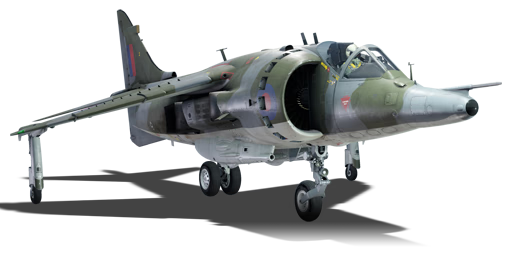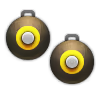



The Harrier GR.3 was a further development of the Harrier series of vertical/short takeoff and landing (V/STOL) jet fighters. It entered service with the Royal Air Force (RAF) in 1976 and was used in various combat operations, including the Falklands War in 1982. The Harrier GR.3 had a number of improvements over the earlier Harrier GR.1, such as a more powerful Pegasus Mk 103 engine, a nose-mounted Laser Rangefinder and Marked Target Spotter (Ferranti LRMTS) for use as a laser receiver, an AN/ALE-40 chaff/flare dispenser for increased survivability, provision for Sidewinder air-to-air missiles, and the addition of a Radar Warning Receiver. The Harrier GR.3 was stationed at several bases worldwide, such as RAF Wittering in England, RAF Gütersloh in Germany, and RAF Stanley in the Falkland Islands. The Harrier GR.3 was also capable of operating from austere and improvised airfields thanks to its V/STOL capability and rugged design. It could take off and land on short runways, roads, or even ships, using a combination of vectored thrust and reaction control systems. This gave it a tactical advantage over conventional jet fighters, which required long runways and extensive support facilities. The Harrier GR.3 proved its versatility and effectiveness during the Falklands War, where it flew from the decks of Royal Navy carriers and from a remote airstrip on Ascension Island. It flew 126 sorties with four losses due to enemy fire. A total of 102 Harrier GR.3s were produced or converted and served in the RAF until they were replaced by newer models in the early 1990s.
The Harrier GR.3 was introduced in Update "New Power". Like all members of the Harrier family, the Harrier GR.3 is a VTOL aircraft with thrust vectoring nozzles, which allow it to take off and land vertically. This version of the Harrier is much easier to operate in air-to-air combat than the Harrier GR.1, thanks to its AIM-9G air-to-air missiles and countermeasures. The Harrier GR.3 can operate at higher altitudes and utilize its Sidewinder missiles to target other aircraft from above, so it is not just confined to operating at low altitudes.
flaps
flaps
flaps
brake
| Belt | Belt filling | Armor penetration (mm) at a distance: | |||||
|---|---|---|---|---|---|---|---|
| 10 m | 100 m | 500 m | 1000 m | 1500 m | 2000 m | ||
| AP/HEI-T | 37 | 34 | 22 | 13 | 8 | 5 | |
| AP/HEI-T/AP | 37 | 34 | 22 | 13 | 8 | 5 | |
| HEF-I/HEI-T | 4 | 4 | 4 | 4 | 4 | 4 | |
| AP/HEF-I | 37 | 34 | 22 | 13 | 8 | 5 | |
| Name | Weight | Slot | ||||
|---|---|---|---|---|---|---|
| 88.4 kg |  |  | ||||
| 18 × | 183.9 kg |  |  | |||
| 213.1 kg |  |  |  |  |  | |
| 36 × | 367.8 kg |  |  | |||
| 2 × | 426.2 kg |  |  | |||
| 486 kg |  |  |  | |||
| 2 × | 972 kg |  |  | |||
| 486 kg |  |  |  | |||
| 2 × | 972 kg |  |  | |||












Flight performance | |
|---|---|
Survivability |
|---|
Weaponry | ||
|---|---|---|